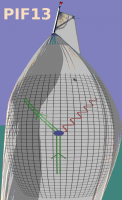Prof.
John Kirk
(MPI Kernphysik)
10/07/2013, 14:00
oral presentation
Current high intensity laser facilities can be used to reach the
regime in which electron trajectories are strongly modified by
the quantum equivalent of the radiation reaction force. We describe a
Monte-Carlo simulation of a set-up in this regime and present results in which GeV electrons counter-propagate into a 10^{22} W/sq cm laser pulse. These show that the stochastic nature of...
Dr
Nina Elkina
(Ludwig-Maximilians University of Munich)
10/07/2013, 14:40
oral presentation
The next generation of laser facilities will make possible to
study electron-positron laser plasma arising due to electromagnetic cascades.
The cascade consists of
quantum electrodynamic effects of hard photon
emission and electron-positron pair creation.
A central problem in description of
plasma with quantum electrodynamic effects is the need for a proper model for radiation,...
Dr
Christopher Harvey
(Queen's University Belfast, UK)
10/07/2013, 15:00
oral presentation
During the next few years a number of new laser facilities are expected to come online (such as ELI and XCELS). These will provide fields of unprecedented powers and intensities, allowing us to explore a range of physics under extreme conditions. In this talk I intend to discuss both classical and quantum aspects of laser-particle interactions and the boundary between the two regimes. I...
Mr
Timon Mehrling
(DESY)
10/07/2013, 15:20
oral presentation
High intensity laser- or particle beams excite large amplitude plasma waves when propagating in appropriate gas targets. The fields, carried by these plasma waves, can exceed 100 GV/m and are capable of accelerating particles to high energies within short distances. To design, advance and understand experiments, numerical investigations of the dynamics in such plasma accelerators are vital....

